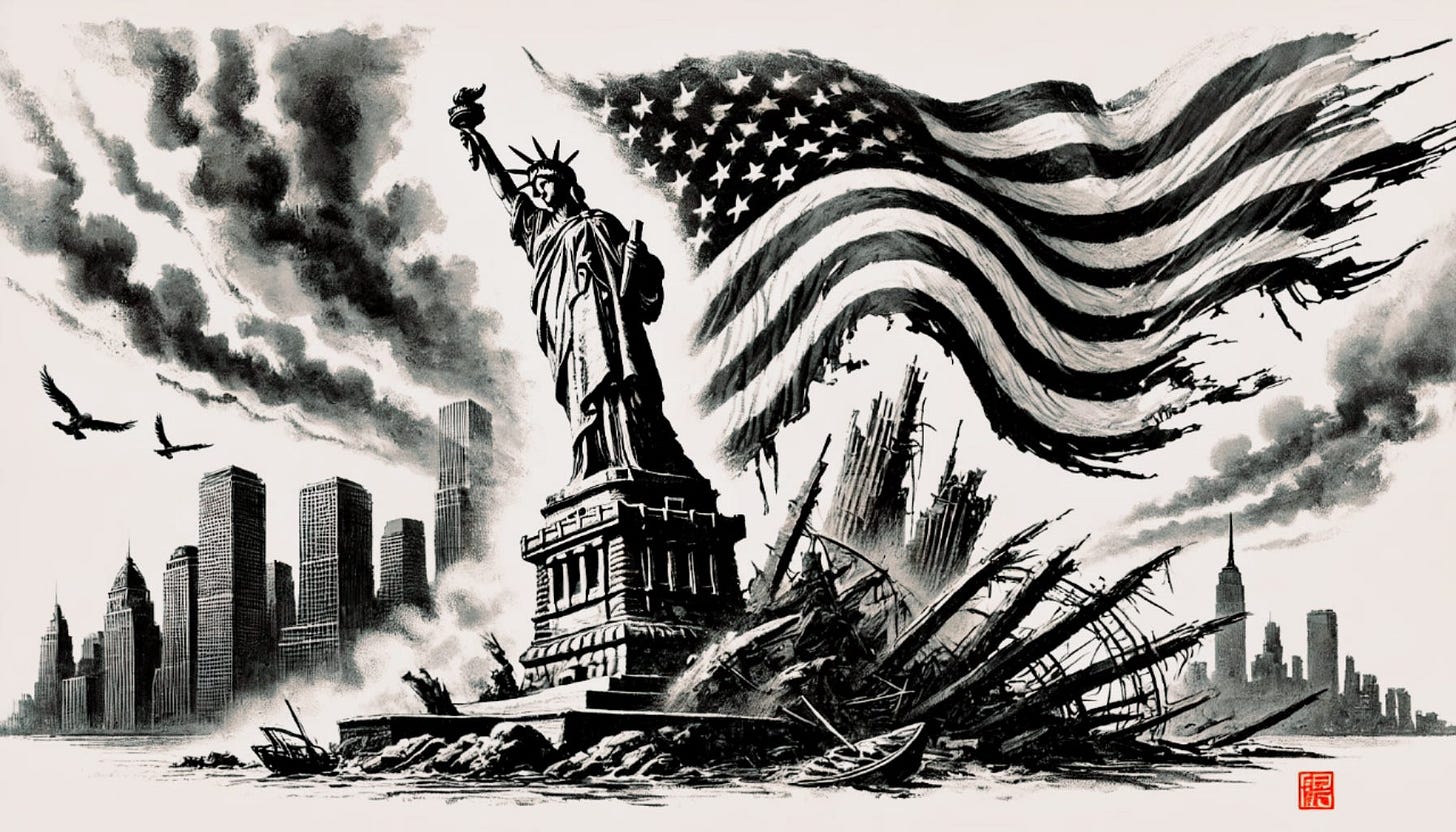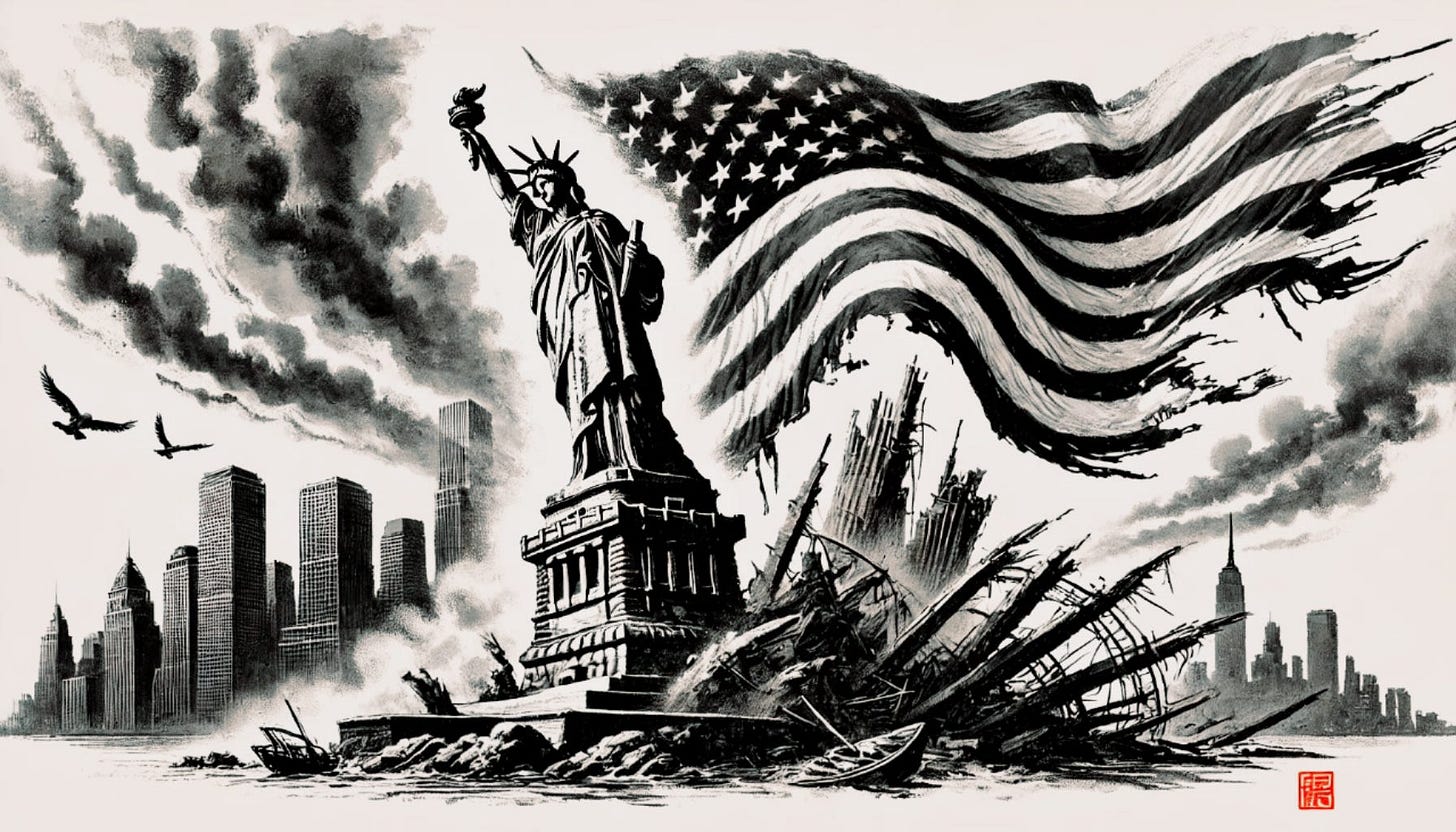Part 1 summary HERE
THE GRAND STRATEGIC CONTEST BETWEEN CHINA AND THE UNITED STATES IN THE 21ST CENTURY: THE GREAT STRUGGLE OF HEGEMONY AND ANTI-HEGEMONY (EXCERPTS: PART 2)
Yan Yilong 鄢一龙
Fudan University China Institute, June 14, 2024
An edited machine translation
Illustration by
OpenAI’s DALL·E 3
V. China’s Need for “Comprehensive Control” (综合制权)
“China's overall strategy is not to collide head-on but to maintain strategic composure, continuously enhance its strength, and exhaust the opponent's power, thereby increasing its comprehensive control over the USA… This comprehensive control is not merely the combined use of control over land, air, sea, space, and cyberspace in traditional warfare but a competition for comprehensive dominance in areas like trade, industrial technology, finance, and cognitive warfare in an ‘unrestricted total war’ (无边界总体战)... China's strategic thinking differs from the West, not resembling the confrontational approach of chess but the long-term game of Go—in which strategic advantage is built over time through a dynamic balance of power.”
“Enhancing comprehensive control involves accumulating sufficient potential energy for the struggle with the USA, following specific paths:
1. Maintain strategic composure and enhance relative strategic advantage. The decline of American hegemony is determined by its internal contradictions. China is on the rise, while American hegemony is in decline… Once China's GDP reaches twice that of the USA, many problems will naturally resolve.”
“2... seizing strategic initiative… After years of Sino-American competition, China has gradually developed its proactive approach, not merely reacting to American moves but forcing the USA to respond to China's actions. For example, in response to China's Belt and Road Initiative, the USA has been forced to launch strategies like ‘Build Back Better World’... although these are clearly not America's strong suits.”
“3. Continuously strengthen strategic advantage without rushing to occupy positions. If the Russia-Ukraine conflict resembles a zero-sum chess match or a Go game where territory is contested, then China's Belt and Road Initiative is more like a Go strategy of building strength. The advantage is that it avoids direct confrontation with the opponent but subtly shifts the balance of power.”
“4. Address strategic weaknesses and enhance strategic coordination… from a long-term perspective, China must first escape the Western discourse trap and build its independent knowledge and discourse systems. Otherwise, even in ideological confrontation with the USA, China cannot escape the traps and standards set by the opponent.”
“5. Build asymmetric advantages in strategic dependencies. In today's globalised world, China and the USA are inevitably interdependent, but China must reduce its dependence on the USA in critical areas, ensuring that it can respond effectively if the USA weaponises this dependency.”
“6. Enhance strategic resilience. Pre-simulations and drills can ensure that China withstands pressure in scenarios where the opponent imposes extreme strategic pressure. Specifically, this includes conducting stress tests for various types of ‘wars’ and disaster impacts that may occur externally”
VI. United Front Against American Hegemony
“In an article published in Foreign Affairs, Biden explicitly stated that the most effective strategy for countering China is to build a community of values and interests to encircle China… Those familiar with Chinese history will find this strategy reminiscent of Su Qin's ‘vertical alliance’ (合纵) strategy over 2,000 years ago… The vertical alliance strategy to encircle the emerging power of Qin ultimately failed against Qin’s horizontal alliance strategy, not just due to Qin's strength but also the prisoner’s dilemma of the vertical alliance.”
“Biden hopes to form a grand alliance among so-called ‘democratic nations’ to counter China. However, this is not an alliance of weaker nations but one led by a powerful country… For the weaker nations in this grand alliance, they must not only jointly counter China but also guard against the United States.”
“...the world's dependence on China far exceeds China’s dependence on other countries. One-third of the world's economies count China as their largest trading partner, and nearly two-thirds rank China among their top three trading partners… Most countries would [therefore] not want to jeopardise their economic relations with China.”
“In response to the USA strategy of building a grand anti-China alliance, China must implement a strategy of grand alliances…Specifically, the grand alliance strategy includes the following elements:
1. Firmly defend the post-World War II world order centred around the United Nations. Today, there are two so-called international orders in the world: one is the post-war world order, a multilateral international order centred around the United Nations; the other is the so-called ‘liberal international order’ that developed during the Cold War, led by the USA to counter the Soviet bloc, with rules set by the USA and imposed on other countries. The "rules-based international order" often cited by the West refers to the latter, while we, like most countries in the world, defend the former and oppose the latter…”
“2. Build a global united front against hegemony, with developing countries as the foundation. The real contradiction facing humanity today is not between so-called ‘liberal democracies’ and ‘authoritarianism’ but between the people's demand for equality and the hegemonism, overbearing behaviour, and bullying of a few countries…
If we wish to create a new world through struggle, we must unite with those countries oppressed by the old world order. China should proactively assist developing countries in achieving industrialisation and defend their interests in international forums. We must also unite with and seek the support of middle forces, including pro-Western developing countries, wavering nations within the USA ally system, and progressive forces within the USA, thereby forming the broadest possible united front against American hegemony…”
“3…China and Russia need to further deepen their ‘back-to-back’ (背靠背) comprehensive strategic partnership in the new era, becoming the mainstay in the great struggle against American hegemony and in promoting the establishment of a new international order.”
“4. Strengthen cooperation with Europe within the Sino-American-European triangle. A strong and unified Europe does not align with America's strategic interests. American hegemony does not allow for challengers, and a divided and weakened Europe enhances American control over Europe, with support for Brexit being one of America's strategic moves to weaken Europe… China is not a strategic adversary of Europe. Although there are ideological differences and competition in some industries, there are no fundamental conflicts of security, interests, or values between China and Europe.”
“5. Promote standardisation and integration in the new era (Yan uses the Chinese idiom ‘cars on the same track’ 车同轨) building the third developed economic circle of humanity and ushering in the Asian century. From the Industrial Revolution to the present, humanity has only seen two developed economic circles: Europe and North America. The 21st century is the Asian century, and as long as Asian countries maintain peaceful and stable development, the third developed economic circle will emerge in Asia.”“We must view changes in Sino-American relations dialectically… Ultimately, it is through great struggle that we aim to break the old unequal structure and proactively lead the formation of a new international order…”
VII. Towards Communitarianism, a non-Western model
“Regardless of the form of hegemony, whether based on coercion or consent, prioritising national interests or professing to serve ‘universal interests,’ it always has two characteristics: inequality and rent-seeking, extracting extra profits from other countries. China's rise does not represent a new hegemony because Chinese civilisation differs from Western civilisation.
Western civilisation is essentially a hierarchical civilisation that contrasts "civilisation" with "barbarism" (文明/野蛮)... During the so-called "Age of Discovery" in the late 15th and early 16th centuries, Westerners used their civilisation to subjugate and transform what they saw as barbarians… In modern times, some Japanese thinkers also embraced this hierarchical view of civilisation…”
“‘America First’ represents hegemonic authoritarianism, while the concept of a ‘community of shared future for mankind’ (人类命运共同体) represents benevolent leadership. The USA practises ‘three hegemonies’: hegemony, overbearing behaviour, and bullying, but the more authoritarian it becomes, the less sustainable it is…Today, American hegemony is not a ‘paper tiger’ but a ‘late-season tiger’ (不是纸老虎而是秋老虎)—still powerful and capable of biting but gradually cooling down.”
“Humanity now stands at a crossroads in globalisation… today, the most important public good in short supply is leadership. China must play a greater global leadership role and point the way towards a brighter future for humanity in the 21st century.”
“President Xi Jinping's concept of a community of shared future for mankind and China's recent diplomatic practices have proposed a new paradigm for 21st-century international relations: communitarianism (共同体主义.) Communitarianism not only aligns with the realities of 21st-century international politics but also responds to its challenges. It also carries an idealistic dimension, reflecting Chinese traditions, Chinese solutions, and Chinese wisdom.
In terms of security, communitarianism is a universal security concept, transcending the ‘balance of power’ and ‘collective security’ frameworks. In terms of development, communitarianism emphasises common development, surpassing the ‘zero-sum’ and ‘liberal’ development models. In terms of civilisation, communitarianism embraces civilisational integration, moving beyond the ‘clash of civilisations’ and ‘multiculturalism.’ In terms of state relations, communitarianism advocates for partnerships, surpassing alliances and non-alignment.”
“Communitarianism represents a new path for globalisation, with the following strategic initiatives:
1. Pursue a new path of ‘open and shared’ (开放共享) globalisation, transcending the ‘divide and conquer’ (人以群分) and ‘each to their own’ (各自为战) approach to globalisation. The economies, technologies, and cultures of countries worldwide are already deeply integrated. We must oppose the use of decoupling and supply chain disruptions as geopolitical weapons and reject supply chains built on so-called shared values.”
“2. Pursue a new path of ‘common development’ in globalisation, transcending the ‘zero-sum competition’ approach to globalisation…The traditional model of government-to-government development cooperation, mainly through international trade and development aid, still faces issues of global development failures and market failures. The Belt and Road Initiative is a new model of intergovernmental cooperation. China engages in strategic alignment and planning coordination with countries along the Belt and Road, building development partnerships…”
“3. Pursue a new path of ‘people-centred’ globalisation (以人民为中心”的全球化), transcending the ‘capital-centred’ (以资本为中心) approach to globalisation. Capital-centred globalisation is driven by the pursuit of capital profits, serving the free operation and flow of capital, making more efficient money, and is the root of unbalanced and insufficient globalisation… The new globalisation must shift from being capital-centred to being people-centred… First, the new globalisation transcends the simple pursuit of profit maximisation… Second, we should guide capital to go global in alignment with national strategies…state-owned capital is the main force driving the new globalisation, with a stronger political orientation, pushing forward many national cooperation projects that are high-risk, long-term, and have small profit margins.”
“4. Pursue a new path of balanced globalisation, transcending the unbalanced globalisation model. China does not seek the extra profits that come from unbalanced globalisation but rather achieves its development through shared progress with the world.”
“5. Pursue a new path of ‘equal-autonomous’ (平等-自主) globalisation, transcending the ‘dominant-dependent’ (支配-依附) globalisation model. China has experienced colonialism and imperialism and deeply understands the challenges developing countries face in an unequal globalisation system…This new path of globalisation requires that no country seek to dominate others, that each country respects the independence of others, does not interfere in their internal affairs, and does not attach political conditions to aid and cooperation.”
“6. Pursue a new path of ‘diverse’ globalisation, transcending the ‘uniform’ globalisation model. Traditional globalisation followed a path of uniformity, attempting to ‘Westernise’ the world…The process of ‘localised’ globalisation means that the new globalisation itself will be diverse, taking on different forms. It is a two-way process, involving both giving and receiving.”
READ the original FULL TEXT
Yan Yilong's On American Hegemony - Part 1
as reposted from





